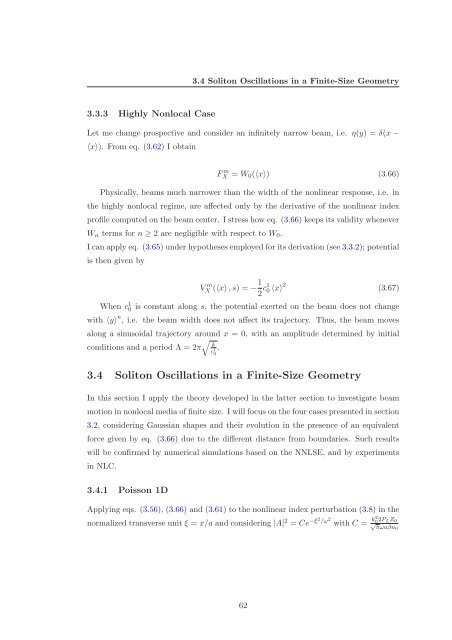Solitons in Nonlocal Media
Solitons in Nonlocal Media
Solitons in Nonlocal Media
Create successful ePaper yourself
Turn your PDF publications into a flip-book with our unique Google optimized e-Paper software.
3.3.3 Highly <strong>Nonlocal</strong> Case<br />
3.4 Soliton Oscillations <strong>in</strong> a F<strong>in</strong>ite-Size Geometry<br />
Let me change prospective and consider an <strong>in</strong>f<strong>in</strong>itely narrow beam, i.e. η(y) = δ(x −<br />
〈x〉). From eq. (3.62) I obta<strong>in</strong><br />
F m X = W0(〈x〉) (3.66)<br />
Physically, beams much narrower than the width of the nonl<strong>in</strong>ear response, i.e. <strong>in</strong><br />
the highly nonlocal regime, are affected only by the derivative of the nonl<strong>in</strong>ear <strong>in</strong>dex<br />
profile computed on the beam center. I stress how eq. (3.66) keeps its validity whenever<br />
Wn terms for n ≥ 2 are negligible with respect to W0.<br />
I can apply eq. (3.65) under hypotheses employed for its derivation (see 3.3.2); potential<br />
is then given by<br />
When c 1 0<br />
V m X (〈x〉,s) = − 1<br />
2 c1 0 〈x〉 2<br />
(3.67)<br />
is constant along s, the potential exerted on the beam does not change<br />
with 〈y〉 n , i.e. the beam width does not affect its trajectory. Thus, the beam moves<br />
along a s<strong>in</strong>usoidal trajectory around x = 0, with an amplitude determ<strong>in</strong>ed by <strong>in</strong>itial<br />
conditions and a period Λ = 2π<br />
k<br />
c 1 0<br />
.<br />
3.4 Soliton Oscillations <strong>in</strong> a F<strong>in</strong>ite-Size Geometry<br />
In this section I apply the theory developed <strong>in</strong> the latter section to <strong>in</strong>vestigate beam<br />
motion <strong>in</strong> nonlocal media of f<strong>in</strong>ite size. I will focus on the four cases presented <strong>in</strong> section<br />
3.2, consider<strong>in</strong>g Gaussian shapes and their evolution <strong>in</strong> the presence of an equivalent<br />
force given by eq. (3.66) due to the different distance from boundaries. Such results<br />
will be confirmed by numerical simulations based on the NNLSE, and by experiments<br />
<strong>in</strong> NLC.<br />
3.4.1 Poisson 1D<br />
Apply<strong>in</strong>g eqs. (3.56), (3.66) and (3.61) to the nonl<strong>in</strong>ear <strong>in</strong>dex perturbation (3.8) <strong>in</strong> the<br />
normalized transverse unit ξ = x/a and consider<strong>in</strong>g |A| 2 = Ce −ξ2 /ω 2<br />
62<br />
with C = k2 0 2PLZ0<br />
√ πωaβn0
















